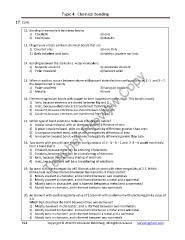Page 204 - Teacher Preview Copy
P. 204
.
Topic 4: Chemical bonding
17. Cont.
12. Bonding in ammonia is best described as
1) Covalent 3) Ionic
2) Coordinate 4) Metallic
13. Magnesium nitrate contains chemical bonds that are
1) Covalent only 3) Ionic Only
2) Both covalent and ionic 4) Neither covalent nor ionic
14. Bonding between the atoms in a water molecule is 3) coordinate covalent
1) Nonpolar covalent
2) Polar covalent 4) Network solid
Teacher Preview Copy
Teacher Preview Copy
15. When a reaction occurs between atoms with ground state electron configurations of 2 -1 and 2 – 7,
the bond formed is mainly
1) Polar covalent 3) Nonpolar covalent
4) Ionic
2) Metallic
16. Element magnesium bonds with oxygen to form magnesium oxide, MgO. This bond is mostly
1) Ionic, because electrons are shared between Mg and O
2) Ionic, because electrons are transferred from Mg to O
3) Covalent, because electrons are shared between Mg and O
4) Covalent, because electrons are transferred from Mg to O
17. Which type of bond exists in a molecule of hydrogen iodide?
1) A polar covalent bond, with an electronegativity difference of zero
2) A polar covalent bond, with an electronegativity difference greater than zero
3) A nonpolar covalent bond, with an electronegativity difference of zero
4) A nonpolar covalent bond, with an electronegativity difference greater than zero
18. Two atoms with ground state electron configurations of 2 – 8 – 8 – 1 and 2- 8 – 6 would most likely
form a bond that is
1) Covalent, because there will be a sharing of electrons
2) Covalent, because there will be a transferring of electrons
3) Ionic, because there will be a sharing of electrons
4) Ionic, because there will be a transferring of electrons
19. An atom with electronegativity of 0.9 bonds with an atom with electronegativity of 3.1. Which
phrase best describes the bond between the elements of these atoms?
1) Mostly covalent in character, and is formed between two nonmetals
2) Mostly covalent in character, and is formed between a metal and a nonmetal
3) Mostly ionic in character, and is formed between a metal and a nonmetal
4) Mostly ionic in character, and is formed between two nonmetals
20. An element with electronegativity value of 3.5 bonds with an element with electronegativity value of
3.0.
Which best describes the bond between these two elements?
1) Mostly covalent in character, and is formed between two nonmetals
2) Mostly covalent in character, and is formed between a metal and a nonmetal
3) Mostly ionic in character ,and is formed between a metal and a nonmetal
4) Mostly ionic in character, and is formed between two nonmetals
194 Copyright © 2010 E3 Scholastic Publishing. All Rights Reserved. Survivingchem.com
Topic 4: Chemical bonding
17. Cont.
12. Bonding in ammonia is best described as
1) Covalent 3) Ionic
2) Coordinate 4) Metallic
13. Magnesium nitrate contains chemical bonds that are
1) Covalent only 3) Ionic Only
2) Both covalent and ionic 4) Neither covalent nor ionic
14. Bonding between the atoms in a water molecule is 3) coordinate covalent
1) Nonpolar covalent
2) Polar covalent 4) Network solid
Teacher Preview Copy
Teacher Preview Copy
15. When a reaction occurs between atoms with ground state electron configurations of 2 -1 and 2 – 7,
the bond formed is mainly
1) Polar covalent 3) Nonpolar covalent
4) Ionic
2) Metallic
16. Element magnesium bonds with oxygen to form magnesium oxide, MgO. This bond is mostly
1) Ionic, because electrons are shared between Mg and O
2) Ionic, because electrons are transferred from Mg to O
3) Covalent, because electrons are shared between Mg and O
4) Covalent, because electrons are transferred from Mg to O
17. Which type of bond exists in a molecule of hydrogen iodide?
1) A polar covalent bond, with an electronegativity difference of zero
2) A polar covalent bond, with an electronegativity difference greater than zero
3) A nonpolar covalent bond, with an electronegativity difference of zero
4) A nonpolar covalent bond, with an electronegativity difference greater than zero
18. Two atoms with ground state electron configurations of 2 – 8 – 8 – 1 and 2- 8 – 6 would most likely
form a bond that is
1) Covalent, because there will be a sharing of electrons
2) Covalent, because there will be a transferring of electrons
3) Ionic, because there will be a sharing of electrons
4) Ionic, because there will be a transferring of electrons
19. An atom with electronegativity of 0.9 bonds with an atom with electronegativity of 3.1. Which
phrase best describes the bond between the elements of these atoms?
1) Mostly covalent in character, and is formed between two nonmetals
2) Mostly covalent in character, and is formed between a metal and a nonmetal
3) Mostly ionic in character, and is formed between a metal and a nonmetal
4) Mostly ionic in character, and is formed between two nonmetals
20. An element with electronegativity value of 3.5 bonds with an element with electronegativity value of
3.0.
Which best describes the bond between these two elements?
1) Mostly covalent in character, and is formed between two nonmetals
2) Mostly covalent in character, and is formed between a metal and a nonmetal
3) Mostly ionic in character ,and is formed between a metal and a nonmetal
4) Mostly ionic in character, and is formed between two nonmetals
194 Copyright © 2010 E3 Scholastic Publishing. All Rights Reserved. Survivingchem.com


